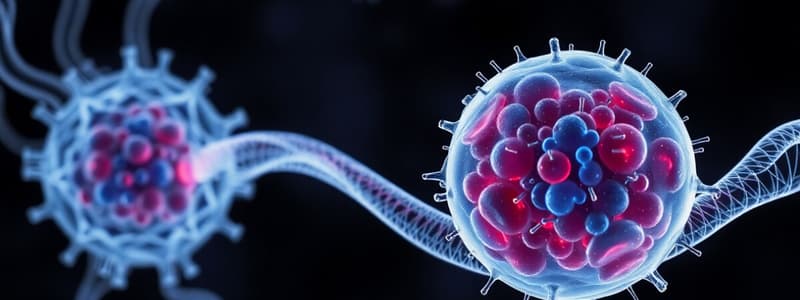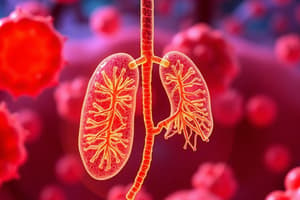Podcast
Questions and Answers
What encompasses the term 'metabolism' in a cell?
What encompasses the term 'metabolism' in a cell?
- Only the degradation of food materials
- All biochemical reactions and physical processes (correct)
- A and C combined
- Only energy production and consumption
What is the primary function of catabolic processes?
What is the primary function of catabolic processes?
- To release energy by breaking down large macromolecules (correct)
- To synthesize ATP from ADP
- To build larger macromolecules
- To absorb energy for cellular function
What is the role of ATP in metabolism?
What is the role of ATP in metabolism?
- To inhibit anabolic processes
- To store energy released during catabolic processes (correct)
- To transport nutrients across cell membranes
- Solely to provide energy for catabolism
Which statement about ATP is true?
Which statement about ATP is true?
What is a key characteristic of an anabolic process?
What is a key characteristic of an anabolic process?
Which of the following correctly describes the relationship between ADP and ATP?
Which of the following correctly describes the relationship between ADP and ATP?
How do phosphate groups in ATP contribute to its energy storage capability?
How do phosphate groups in ATP contribute to its energy storage capability?
What must occur during catabolic processes to form ATP?
What must occur during catabolic processes to form ATP?
Which of the following is correct about both catabolic and anabolic pathways?
Which of the following is correct about both catabolic and anabolic pathways?
What is the primary function of the adenosine molecule as described?
What is the primary function of the adenosine molecule as described?
Which type of respiration is the most common form of catabolism?
Which type of respiration is the most common form of catabolism?
Which of the following organisms primarily utilizes aerobic respiration?
Which of the following organisms primarily utilizes aerobic respiration?
Which type of respiration is performed by some prokaryotes but is not common?
Which type of respiration is performed by some prokaryotes but is not common?
What is true about fermentation in relation to the other strategies for ATP production?
What is true about fermentation in relation to the other strategies for ATP production?
Which of the following best describes anaerobic respiration compared to aerobic respiration?
Which of the following best describes anaerobic respiration compared to aerobic respiration?
How many main strategies are identified for making ATP?
How many main strategies are identified for making ATP?
Fermentation occurs as a strategy in which types of organisms?
Fermentation occurs as a strategy in which types of organisms?
Which statement is not true regarding aerobic respiration?
Which statement is not true regarding aerobic respiration?
What distinguishes anaerobic respiration from aerobic respiration?
What distinguishes anaerobic respiration from aerobic respiration?
Metabolism includes only the degradation pathways that break down food.
Metabolism includes only the degradation pathways that break down food.
Catabolism is responsible for building larger molecules from smaller ones.
Catabolism is responsible for building larger molecules from smaller ones.
Anabolism requires energy input to build larger molecules.
Anabolism requires energy input to build larger molecules.
ATP acts as an energy storage molecule between catabolism and anabolism.
ATP acts as an energy storage molecule between catabolism and anabolism.
Adenosine triphosphate (ATP) has only two phosphate groups.
Adenosine triphosphate (ATP) has only two phosphate groups.
ATP can store and release energy because of the structure of its phosphate groups.
ATP can store and release energy because of the structure of its phosphate groups.
During catabolism, energy is consumed to form ATP.
During catabolism, energy is consumed to form ATP.
Phosphate groups in ATP do not repel each other due to their negative charge.
Phosphate groups in ATP do not repel each other due to their negative charge.
Aerobic respiration is utilized exclusively by eukaryotes.
Aerobic respiration is utilized exclusively by eukaryotes.
The process of converting ADP back to ATP occurs continuously in the cell.
The process of converting ADP back to ATP occurs continuously in the cell.
Anaerobic respiration is a common strategy used by most organisms on Earth.
Anaerobic respiration is a common strategy used by most organisms on Earth.
Adenosine triphosphate (ATP) is not crucial for cellular functions.
Adenosine triphosphate (ATP) is not crucial for cellular functions.
Fermentation is employed as a primary strategy for ATP production by many eukaryotes.
Fermentation is employed as a primary strategy for ATP production by many eukaryotes.
ADP and ATP are transformed from one to the other hundreds of times a second in the process of energy storage and release.
ADP and ATP are transformed from one to the other hundreds of times a second in the process of energy storage and release.
All organisms on Earth are capable of fermentation as a strategy for ATP production.
All organisms on Earth are capable of fermentation as a strategy for ATP production.
The main strategies for ATP production include aerobic respiration, anaerobic respiration, and ATP synthesis.
The main strategies for ATP production include aerobic respiration, anaerobic respiration, and ATP synthesis.
Some prokaryotes can perform anaerobic respiration.
Some prokaryotes can perform anaerobic respiration.
Aerobic respiration is a less efficient way to produce ATP compared to anaerobic respiration.
Aerobic respiration is a less efficient way to produce ATP compared to anaerobic respiration.
The most common form of catabolism among organisms is anaerobic respiration.
The most common form of catabolism among organisms is anaerobic respiration.
Fermentation can be considered a common method for ATP production among many organisms.
Fermentation can be considered a common method for ATP production among many organisms.
Flashcards are hidden until you start studying
Study Notes
Metabolism
- Metabolism encompasses all chemical reactions and physical processes within a cell.
- Breakdown of food and creation of new cell membranes are examples of metabolic processes.
Catabolic and Anabolic Pathways
- Catabolism breaks down macromolecules into smaller molecules, releasing energy.
- Anabolism constructs larger molecules from smaller ones, requiring energy.
- ATP serves as the energy currency for the cell.
ATP Structure and Function
- ATP is composed of adenosine (ribose and adenine) and three phosphate groups.
- The bonds between phosphate groups are high-energy bonds due to the repulsion of negatively charged groups.
- ATP stores energy by adding a phosphate group to ADP (adenosine diphosphate).
- ATP releases energy when it loses a phosphate group, reverting to ADP.
- The cell constantly cycles between ATP and ADP to manage energy.
Catabolic Strategies for ATP Production
- Aerobic respiration is the most common method, utilized by eukaryotes and many prokaryotes.
- Anaerobic respiration is less frequent, employed by some prokaryotes.
- Fermentation is a less efficient strategy, utilized by a few eukaryotes and some prokaryotes as a last resort.
Metabolism
- Metabolism is the sum of all chemical reactions and physical processes in a cell.
- It encompasses both breakdown (catabolism) and synthesis (anabolism) of molecules.
- Catabolic pathways break down large macromolecules into smaller molecules, releasing energy.
- Anabolic pathways use small molecules to build larger ones, requiring energy input.
- The energy released during catabolism is stored as ATP, which is then used to drive anabolism.
Adenosine Triphosphate (ATP)
- ATP is a vital energy storage molecule crucial for cellular processes.
- It stores energy released from catabolism and releases it for anabolism.
- ATP consists of adenosine (ribose and adenine) with three phosphate groups attached.
- The phosphate groups are negatively charged and have a high potential energy due to repulsion.
- The bonds between phosphate groups are called "high energy phosphate bonds".
- ATP can readily gain and lose a phosphate group, cycling between ATP and ADP (adenosine diphosphate).
- During catabolism, energy is used to add a phosphate group to ADP, forming ATP.
- During anabolism, the last phosphate group is removed from ATP, releasing energy and forming ADP.
ATP Production Strategies
- Three main strategies for ATP production: aerobic respiration, anaerobic respiration, and fermentation.
Aerobic Respiration
- The most common form of catabolism used by eukaryotes and many prokaryotes.
Anaerobic Respiration
- A less common strategy used by some prokaryotes.
Fermentation
- A last resort strategy used by a few eukaryotes and some prokaryotes.
Studying That Suits You
Use AI to generate personalized quizzes and flashcards to suit your learning preferences.




